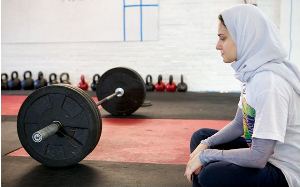WEIGHT TRAINING
 Weight training is a form of strength training to build muscles using weights and can be used for losing weight, strengthening muscles and general fitness. Weight training uses the force of gravity against weight training equipment to work out body muscles.
Weight training is a form of strength training to build muscles using weights and can be used for losing weight, strengthening muscles and general fitness. Weight training uses the force of gravity against weight training equipment to work out body muscles.
It has been used for hundreds of years to increase body strength from the beginning of recorded history when warriors lifted weights to increase their prowess in battle. In modern times men’s weight lifting was introduced as an Olympic official sport in 1896 and the women’s was introduced in the year 2000.
THE PRINCIPLES OF WEIGHT TRAINING
To be successful at weight training there are some principles that you should adhere to so that over a period of time you can see progress in your work out.
Progressive overload: This means that once the body gets used to or adapts to a certain workout you must increase the stress to maintain results. You can do this in several ways.
• Adding more repetition to your regular ones.
• Increasing the number of sets you perform for example if your normal sets are twenty you can increase them to twenty five.
• Changing your pace perhaps slowing it down so that your muscles experience more stress.
• Increasing the mass of weights that you are lifting.
Specificity: This refers to designing a weight training program according to your desired results. For example if you want to strengthen your legs then you must follow a training regime that focuses on strengthening your legs.
Accommodation: This principle of weight training recognises that when the same exercise regime is used over a period of time its benefits are reduced. Therefore for weight training program to be efficient, it must have variation and still be geared towards your desired results.
Stress and Rest: Weight training involves placing progressive stress on the body muscles and to avoid injury it is important to have periods of rest between the training.
The minimum time of rest between workouts should be 48 hours. Besides avoiding injury resting between workouts ensures that the muscles adapt to the increasing stress and allows them time to grow.
BASIC WEIGHT TRAINING EQUIPMENT
 Dumbbells – There are numerous weight training exercise where you can use dumbbells so these are worth investing in. They come in different weights which accommodate the increasing results you will be targeting. You should start with light dumbbells and as you gain strength increase the weight.
Dumbbells – There are numerous weight training exercise where you can use dumbbells so these are worth investing in. They come in different weights which accommodate the increasing results you will be targeting. You should start with light dumbbells and as you gain strength increase the weight.
Weight lifting gloves – The purpose of weight lifting gloves is to protect your hands from blisters and also to prevent your hands from becoming slippery which can cause injury. If your budget allows you can go for the gloves that have fastening straps which hold your wrist in place when you lift weights.
Adjustable weight bench – This is necessary for your chest and back exercises which may need a flat or inclined bench.
Weight belts – A weight belt is fastened round your waist and its purpose is to support your back and keep it aligned when exercising the legs and the back. Note that the belt helps you keep safe but does not prevent you from falling or other accidents.
Barbells – The type of barbell you choose will depend on your training and experience. The ideal barbells to begin with are the ones loaded with plates and you can increase the weight of the plates as you get further into your workout.
WEIGHT TRAINING SAFETY TIPS
Safety is a key issue in weight training because it involves equipment which can cause permanent or serious harm to your body if care is not exercised. To be safe here are some tips to keep in mind when weight training.
• One of the not-so-obvious ways that you can get injured when weight lifting is by not doing the exercise in the correct way. Ask for help when you don’t know how to do an exercise or how to use particular equipment.
• Barbells are ideal for weight lifting however they do carry the risk of injury when a plate has not been fastened properly. If it comes loose it can cause you injury as well as anybody else standing nearby. When working with barbells or bars double check that the plates are secure.
• As with all types of exercises, warming up before weight lifting will save you from injury and from muscle pain. You can warm up with light weights or barbells.
• Do your lifting in a slow steady manner as opposed to jerky movements which can cause injury. Awkward lifting of weights strains the joints and the bones. The aim is to stress the muscles not injure them.
• When lifting use the muscles of your legs to lift the weight rather than your back which is weak and prone to injury. To use the leg muscles bend your knees slightly and the weight will be on your legs not your back.
THE BENEFITS OF WEIGHT TRAINING
 Endurance: Wouldn’t you love to increase the amount of physical work that you can do without feeling like you’ll collapse from exhaustion after ten minutes? Well you can by weight lifting training. One of the benefits of weight training is that it steadily increases your capacity for physical work and you are able to worker for longer periods of time.
Endurance: Wouldn’t you love to increase the amount of physical work that you can do without feeling like you’ll collapse from exhaustion after ten minutes? Well you can by weight lifting training. One of the benefits of weight training is that it steadily increases your capacity for physical work and you are able to worker for longer periods of time.
Bone Density: As you age, your bones lose their density, making you more susceptible to injury and osteoporosis –a condition that makes bones weak and fragile. Weight lifting counters this by increasing your bone density thereby protecting you from weak bones.
Life Quality: Your quality of life increases as your body gains strength and your self-esteem rises. When you weight lift, you tone your body and this makes you feel good about yourself. This in turn makes you enjoy life and seek out more ways to add value to your life.
Reduced Body Fat: Weight lifting decreases your body fat. This decreases your chances of getting cardiovascular disease and other illnesses associated with increased body fat like diabetes and stroke.
Better Posture: Many people have a tendency to slump when they feel tired. Weight lifting improves your posture and eliminates back pain which is associated with bad posture. A straighter back means a healthier spine.
